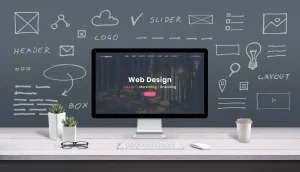What Is Website Animation and Why It Matters
At its core, website animation uses motion to guide attention, provide feedback, and explain change over time. That might be a microinteraction (like a button ripple), a loading indicator, or a content transition that shows where information came from and where it’s going.
The biggest UX animation benefits revolve around cognition and clarity. Motion can reduce cognitive load by illustrating cause and effect, helping users build a mental model of your interface. When done right, animation clarifies, not distracts.
Exclusive UX Animation Benefits You Can’t Ignore
Many teams use motion for flair, but the most successful products use website animation to solve real UX problems. Here are the benefits that consistently move the needle:
- Focus and attention management: Motion draws the eye to important elements at just the right moment, preventing missed messages or errors.
- Spatial understanding: Animated transitions explain how views relate—like sliding from a list to a detail page—preserving context and reducing disorientation.
- System feedback and status: Loading states, progress animations, and success/failure cues reassure users that the system is working and time is not wasted.
- Perceived performance: Well-timed loaders and skeleton screens make waits feel shorter, maintaining user momentum and trust.
- Brand personality: Signature motion patterns create a distinctive feel that increases memorability without relying on heavy visuals.
- Error prevention and recovery: Subtle shakes, highlights, or animated tooltips can prevent invalid submissions and guide quick fixes.
These UX animation benefits compound: clearer context reduces errors, which increases conversions and satisfaction. The outcome? Stronger retention and better business metrics.
Research-Backed Principles for Effective Website Animation
Evidence supports the cognitive and usability advantages of motion. The Nielsen Norman Group has long noted that animation enhances the perception of causality and states when kept purposeful and fast enough. See their guidance on animation and usability for patterns that improve clarity and reduce confusion (Nielsen Norman Group).
Additional findings from human–computer interaction research show that users form first impressions of visual appeal within milliseconds, and subtle motion can reinforce professional polish during that critical window. While website animation is not a substitute for content or performance, it amplifies them when it mirrors real-world physics and intent.
Key takeaways that underpin UX animation benefits include:
- Purpose over decoration: Every animation should have a job—direct attention, indicate a state change, or confirm an action.
- Timing and easing: Durations between 150–300ms with ease-in-out curves generally feel natural and responsive.
- Consistency: Reusing the same motion patterns builds trust and recognition across your interface.
Best Practices for High-Performance Website Animation
Performance is a critical factor that determines whether website animation helps or hurts your UX. Here are guidelines to ensure motion enhances rather than hinders:
- Use transform and opacity: Favor CSS
transformandopacityfor smooth, GPU-accelerated effects. Avoid layout-thrashing properties liketop,left, orwidthwhere possible. - Keep it short and snappy: Most UI animations should land between 150–300ms. Reserve longer timings for transitions between distinct contexts (e.g., opening a modal) up to ~400ms.
- Design for reduced motion: Respect
prefers-reduced-motionand provide alternatives like instant state changes or simplified fades for motion-sensitive users. - Optimize assets: Replace heavy GIFs with vector-based formats (e.g., Lottie or CSS) and lazy load non-critical motion.
- Measure and iterate: Track Core Web Vitals and interaction latency. If animation hurts responsiveness, refactor or remove it.
Following these practices protects the core UX animation benefits—clarity and speed—while keeping your interface inclusive and fast.
Where Website Animation Delivers the Biggest ROI
Not all interactions need motion. Focus your website animation budget on points of friction and high-value journeys where motion can clarify or accelerate decisions.
1) Navigation and Hierarchy
Use animated transitions to show where users are going. A slide or scale transition from a card to its details page preserves spatial continuity. This supports the UX animation benefits of reduced disorientation and stronger wayfinding.
2) Form Validation and Checkout
Micro-animations—shakes for invalid fields, checkmarks for success—help users correct errors fast. In checkouts, animated progress indicators and instant feedback reduce abandonment by maintaining user confidence.
3) Onboarding and Empty States
Animated illustrations or step hints can demonstrate how to use features more effectively than static text. Keep motion functional and short to avoid novelty fatigue.
4) Loading and Perceived Performance
Skeleton screens and progress animations communicate that content is on the way. By managing user expectations, website animation can reduce perceived wait time and boost satisfaction.
5) Microinteractions that Reinforce Brand
A subtle hover expansion on CTAs or a tasteful logo reveal can impart polish. The goal is to make interactions feel responsive and human, reinforcing the product’s personality without slowing the experience.
Real-World Examples: UX Animation Benefits in Action
Consider an e-commerce brand revamping product discovery. They added animated filters that expand/collapse with a spring easing, a fade-in for loaded thumbnails, and a progress bar for add-to-cart. Result: fewer misclicks and a measurable uptick in completion rates for filter usage, thanks to clearer affordances and state transitions.
A SaaS dashboard introduced animated sorting cues (arrows that subtly rotate and highlight) and table row expansion transitions. Support tickets referencing “confusing sorting” dropped, and time-to-insight for power users improved—evidence that website animation can reduce cognitive friction in data-heavy contexts.
In both cases, the core UX animation benefits were the same: improved clarity, faster recovery from errors, and stronger user confidence, all delivered with lightweight, accessible motion.
Motion Design System: Scaling Website Animation Across Teams
To scale consistently, treat website animation as a first-class design token. Define timing, easing, and use cases in your design system so every contributor can implement motion predictably.
- Timing scale: XS: 120ms (micro), S: 180ms (hover/focus), M: 240ms (state change), L: 320ms (modal/overlay), XL: 400ms (page transition).
- Easing tokens: Ease-in for entering, ease-out for exiting, ease-in-out for continuous transitions; use cubic-bezier variables to match your brand’s energy.
- Component guidance: Document which components animate (and how) for hover, focus, active, loading, and error states.
- Do/Don’t patterns: Do animate only one or two properties; don’t chain excessive effects or conflict with user-initiated motion.
This systemization cements the UX animation benefits of consistency and predictability, which are essential for trust and learnability.
Accessibility and Ethics: Inclusive Website Animation
Animation can affect motion-sensitive users. Inclusive website animation respects user preferences and reduces unnecessary movement while preserving clarity.
- Prefers-reduced-motion: Offer equivalent, non-motion cues—like color or icon changes—and disable parallax or large-scale motion when users opt out.
- Contrast and focus: Motion should not replace visible focus states; maintain keyboard navigability and readable contrast.
- Avoid harmful patterns: Flashing content or rapid oscillations can trigger adverse reactions; follow WCAG recommendations.
Ethical motion ensures the UX animation benefits are available to everyone, while building brand goodwill and compliance.
Measuring Impact: Proving the ROI of Website Animation
Treat motion like any other UX investment: hypothesize, test, measure, and iterate. Tie website animation to outcomes that matter.
- Define the job: “Reduce form submission errors,” “Increase engagement with onboarding,” or “Improve perceived speed.”
- Instrument events: Track interactions (hover, focus, click-through), error rates, and completion times.
- A/B test: Compare animated vs. static variants to isolate the effect of motion on conversion and task success.
- Monitor performance: Ensure no regression in Core Web Vitals. If LCP/INP worsens, refactor the animation.
When you align motion with user tasks and measure outcomes, the UX animation benefits become visible in your analytics and revenue.
Implementation Tips: Practical Patterns for Website Animation
Here are quick wins to integrate website animation into your product without a redesign:
- Button feedback: Add press-state compressions (scale 0.98) and release bounces (scale 1 with ease-out) within 120–160ms.
- List-to-detail transition: Animate the selected card expanding into the detail view to preserve context.
- Progress and skeletons: Replace spinners with skeleton loaders and add a subtle shimmer to imply movement.
- Inline validation: On blur, animate error messages with a gentle fade and slide; don’t wait for submit.
- Hover intent: Delay hover animations by ~80ms to avoid flicker from accidental passes.
These patterns deliver immediate UX animation benefits while being lightweight and accessible.
Common Pitfalls That Undermine UX Animation Benefits
Even good intentions can backfire. Avoid these traps so your website animation strategy remains user-first:
- Over-animation: Too many moving parts create noise, distract from content, and increase cognitive load.
- Slow timings: Animations that lag beyond 400ms feel sluggish and unresponsive.
- Motion without meaning: Decorative effects that don’t map to a user action or system state erode trust.
- Ignoring preferences: Failing to respect reduced-motion settings excludes users and can trigger discomfort.
- Performance hits: Heavy assets, main-thread blocking, or layout thrashing will negate any UX animation benefits.
Conclusion: Make Website Animation Work for Users and Business
Website animation is most powerful when it clarifies, reassures, and accelerates the journey. The exclusive UX animation benefits—better focus, spatial understanding, perceived performance, and reduced errors—translate into higher satisfaction and conversions. Start small with purposeful microinteractions, codify motion in your design system, respect accessibility, and measure outcomes. Do this consistently and your motion strategy becomes a durable competitive edge.



